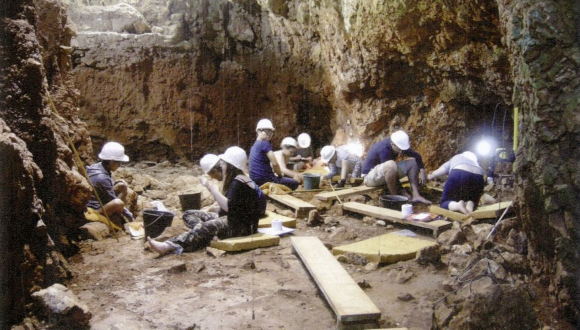Early humans placed their hearths for maximum warmth and minimum smoke exposure

TAU findings indicate that early humans utilized efficient spatial planning
Support this researchA groundbreaking study in prehistoric archaeology at Tel Aviv University (TAU) provides evidence for high cognitive abilities in early humans who lived 170,000 years ago. They discovered that the early humans who occupied the cave had placed their hearth at an optimal location, enabling maximum utilization of the fire for their activities and needs while exposing them to a minimal amount of smoke.
The TAU researchers developed a software-based smoke dispersal simulation model and applied it to a known prehistoric site to reach their conclusions. The study was led by PhD student Yafit Kedar and Professor Ran Barkai of TAU’s Jacob M. Alkow Department of Archaeology and Ancient Near Eastern Cultures, together with Dr. Gil Kedar. The paper was published in Scientific Reports.
Kedar explains that the use of fire by early humans has been debated by researchers for many years. At what point in their evolution did humans learn how to control fire and ignite it at will? When did they begin to use it on a daily basis? Did they use the inner space of the cave efficiently in relation to the fire? While all researchers agree that modern humans were capable of all these things, the dispute continues about the skills and abilities of earlier types of humans.
“One focal issue in the debate is the location of hearths in caves occupied by early humans for long periods of time,” Kedar observes. “Multilayered hearths have been found in many caves, indicating that fires had been lit at the same spot over many years. In previous studies, using a software-based model of air circulation in caves, along with a simulator of smoke dispersal in a closed space, we found that the optimal location for minimal smoke exposure in the winter was at the back of the cave. The least favorable location was the cave’s entrance.”
In the current study, the researchers applied their smoke dispersal model to an extensively studied prehistoric site, the Lazaret Cave in southeastern France, inhabited by early humans around 170-150 thousand years ago. “According to our model, based on previous studies, placing the hearth at the back of the cave would have reduced smoke density to a minimum, allowing the smoke to circulate out of the cave right next to the ceiling,” Kedar says. “But in the archaeological layers we examined, the hearth was located at the center of the cave. We tried to understand why the occupants had chosen this spot, and whether smoke dispersal had been a significant consideration in the cave’s spatial division into activity areas.”
To answer these questions, the researchers performed a range of smoke dispersal simulations for 16 hypothetical hearth locations inside the 290 square meter cave. For each hypothetical hearth ,they analyzed smoke density throughout the cave using thousands of simulated sensors placed 50cm apart from the floor to the height of 1.5m. These measurements were compared with the average smoke exposure recommendations of the World Health Organization.
“We found that the average smoke density, based on measuring the number of particles per spatial unit, is in fact minimal when the hearth is located at the back of the cave – just as our model had predicted,” the researchers explain. “But we also discovered that in this situation, the area with low smoke density, most suitable for prolonged activity, is relatively distant from the hearth itself.
“Early humans needed a balance – a hearth close to which they could work, cook, eat, sleep, get together, warm themselves, etc. – while exposed to a minimum amount of smoke. Ultimately, when all needs are taken into consideration, both daily activities and the damages of smoke exposure, the occupants placed their hearth at the optimal spot in the cave.”
“Our study shows that early humans were able, with no sensors or simulators, to choose the perfect location for their hearth and manage the cave’s space as early as 170,000 years ago – long before the advent of modern humans in Europe,” Professor Barkai concludes. “This ability reflects ingenuity, experience, and planned action, as well as awareness of the health damage caused by smoke exposure. In addition, the simulation model we developed can assist archaeologists excavating new sites, enabling them to look for hearths and activity areas at their optimal locations.”